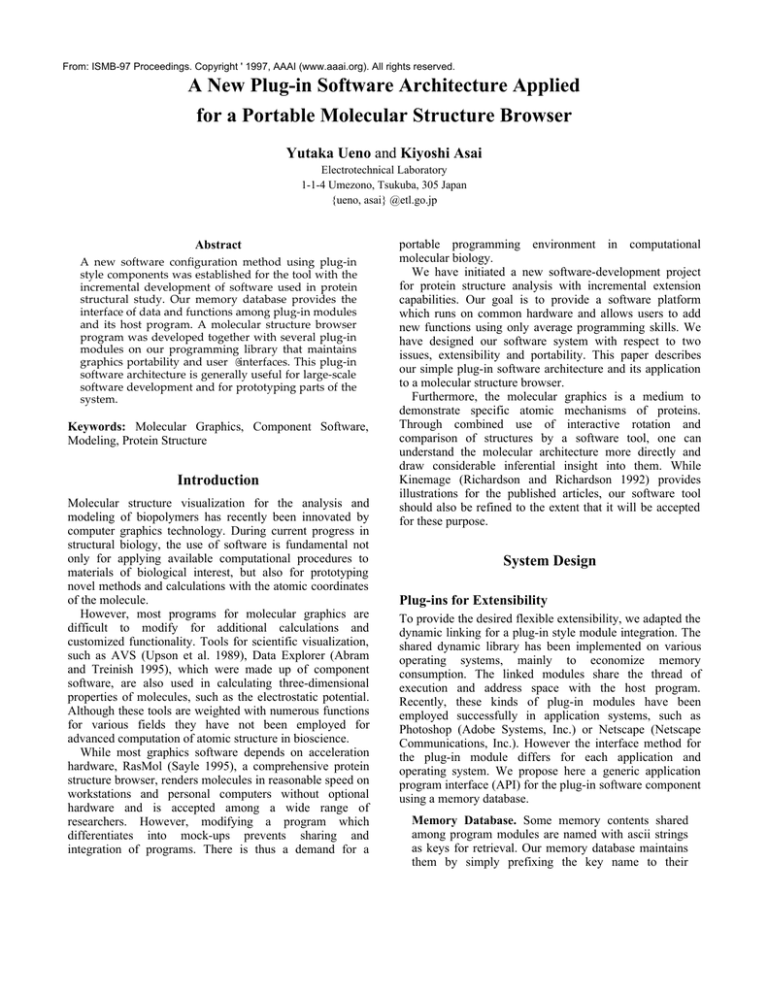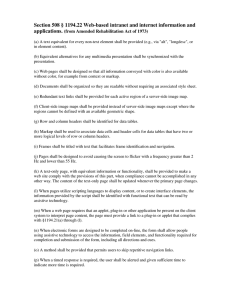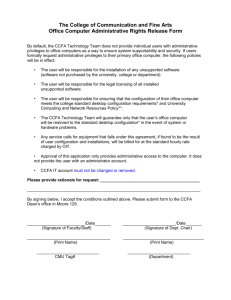
From: ISMB-97 Proceedings. Copyright ' 1997, AAAI (www.aaai.org). All rights reserved.
A New Plug-in Software Architecture Applied
for a Portable Molecular Structure Browser
Yutaka Ueno and Kiyoshi Asai
Electrotechnical Laboratory
1-1-4 Umezono, Tsukuba, 305 Japan
{ueno, asai} @etl.go.jp
Abstract
A new software configuration method using plug-in
style components was established for the tool with the
incremental development of software used in protein
structural study. Our memory database provides the
interface of data and functions among plug-in modules
and its host program. A molecular structure browser
program was developed together with several plug-in
modules on our programming library that maintains
graphics portability and user @interfaces. This plug-in
software architecture is generally useful for large-scale
software development and for prototyping parts of the
system.
Keywords: Molecular Graphics, Component Software,
Modeling, Protein Structure
Introduction
Molecular structure visualization for the analysis and
modeling of biopolymers has recently been innovated by
computer graphics technology. During current progress in
structural biology, the use of software is fundamental not
only for applying available computational procedures to
materials of biological interest, but also for prototyping
novel methods and calculations with the atomic coordinates
of the molecule.
However, most programs for molecular graphics are
difficult to modify for additional calculations and
customized functionality. Tools for scientific visualization,
such as AVS (Upson et al. 1989), Data Explorer (Abram
and Treinish 1995), which were made up of component
software, are also used in calculating three-dimensional
properties of molecules, such as the electrostatic potential.
Although these tools are weighted with numerous functions
for various fields they have not been employed for
advanced computation of atomic structure in bioscience.
While most graphics software depends on acceleration
hardware, RasMol (Sayle 1995), a comprehensive protein
structure browser, renders molecules in reasonable speed on
workstations and personal computers without optional
hardware and is accepted among a wide range of
researchers. However, modifying a program which
differentiates into mock-ups prevents sharing and
integration of programs. There is thus a demand for a
portable programming environment in computational
molecular biology.
We have initiated a new software-development project
for protein structure analysis with incremental extension
capabilities. Our goal is to provide a software platform
which runs on common hardware and allows users to add
new functions using only average programming skills. We
have designed our software system with respect to two
issues, extensibility and portability. This paper describes
our simple plug-in software architecture and its application
to a molecular structure browser.
Furthermore, the molecular graphics is a medium to
demonstrate specific atomic mechanisms of proteins.
Through combined use of interactive rotation and
comparison of structures by a software tool, one can
understand the molecular architecture more directly and
draw considerable inferential insight into them. While
Kinemage (Richardson and Richardson 1992) provides
illustrations for the published articles, our software tool
should also be refined to the extent that it will be accepted
for these purpose.
System Design
Plug-ins for Extensibility
To provide the desired flexible extensibility, we adapted the
dynamic linking for a plug-in style module integration. The
shared dynamic library has been implemented on various
operating systems, mainly to economize memory
consumption. The linked modules share the thread of
execution and address space with the host program.
Recently, these kinds of plug-in modules have been
employed successfully in application systems, such as
Photoshop (Adobe Systems, Inc.) or Netscape (Netscape
Communications, Inc.). However the interface method for
the plug-in module differs for each application and
operating system. We propose here a generic application
program interface (API) for the plug-in software component
using a memory database.
Memory Database. Some memory contents shared
among program modules are named with ascii strings
as keys for retrieval. Our memory database maintains
them by simply prefixing the key name to their
Hardware Independent
Electron
Density
Molecular Structure
Browser Program
Application Support
Hybrid Library
UNIX
I/F
UNIX OS
Superposition
Plug-in
Modules
Network
Driver
Plug-in
Drivers
Memory Database
X-win
I/F
GL
Driver
X-Window
System
OpenGL
Graphics Acceleration Hardware
under development
Hardware Dependent
Fig.1. Software Configuration. An application and plug-ins built on the application support
hybrid libray. The plug-in Drivers interface to the specific hardware.
content. The key name is used as an alternative to a
memory handle, which is an address pointer. Data is
created sequentially in a list where the key name is
unique inside the list. There is the order list that
enumerates the address of functions as registered
software services to be called by their key names.
A plug-in module is built by an object file linker of the
operating system as a shared library. When a plug-in
module is loaded into the host program, the function
Plugin() is called instead of main(). It deposits data and
functions into the memory database to be referred from
other modules. CreateBean() creates a datum in a list on
memory database with key name and data size, whose
address is retrieved by Fetch(). TakeOrder() registers an
address of function with its key name as an order, which is
called by GiveOrder() with arguments.
Symbols of data and functions in a host program are
referred to in plug-in modules as if they are linked, but the
symbols in a plug-in are only visible inside the plug-in.
Since direct finding of the address of a symbol in a plug-in
module results in invalid addressing upon detaching the
module, we recommend the use of memory database which
is aware of the plug-in status. Global variables are also
shared, but run the risk of name conflicts.
Since the plug-in interface in memory database is
established by plug-in itself, the host program can bind a
new plug-in module without knowledge about the plug-in.
As long as new plug-ins are consistent with the host
program and other plug-ins, they can be added to the
software system incrementally.
Graphics and User Interface Library
Graphics and graphical user interface (GUI) libraries are the
predominant answer to the problem of portability. We have
designed our library to be portable and suitable for sphere
and cylinder primitives. The library renders them into an off
screen image buffer with Z-buffer and transfers to the video
RAM in the same way as RasMol (Sayle 1995) together
with our proprietary algorithm of arc generation for
antialiasing sphere (unpublished). The image buffer for
rendering is customizable and can also act as an animation
frames.
The GUI library is also redesigned for the adapting plugin environment. Individual GUI parts in a dialog box
opened by a plug-in are created in memory database so that
other modules can access those parameters given by the
user interface. The key name of the GUI can contain an
order name of its callback function.
Implementation
Our program system was configured as an application
program and its supporting library (Fig. 1). The Application
Support Hybrid Library is responsible for the portability of
the software system and the interface to the plug-in module.
the main
menu bar
tool bar
sequence window
Fig.2. A Typical View of the Molecular Structure Browser. An Insulin monomer
was depicted with a sequence window.
ANSI C language was used to maximize portability. The
program and plug-ins were tested to work on several UNIX
systems (Silicon Graphics, Inc.; Sun Microsystems, Inc.;
Hewlett Packard Co.; Digital Equipment Corp. and Linux
operating system (Torvalds) on IBM-PC) with a Xlib
library for the X Window System. More than 16 Mbytes of
main memory and 8 bit color or gray scale monitor were
required.
Molecular Structure Browser
The molecular structure browser, MOSBY, was
successfully implemented with the following basic
browsing functions of atomic coordinates of proteins:
£Molecular models of wire frame, ball & stick, tube and
space filling.
£Real-time viewing manipulation of molecules by mouse
operations with depth-cueing, clipping, scroll, and
perspective.
£A sequence window provides the amino acid sequence
view of the protein. The selection of residue also
cooperates with the molecular model window and vice
versa.
Most operations are in the main menu bar on top of the
window (Fig. 2). Items in the tool bar at the left side select
the mode of mouse operation. With the default
configuration of the program, the size of a molecule is up to
~100,000 atoms and ~10,000 residues, the size of the image
data is 1600x1200 in 8 bit color with 16 bits of depth buffer.
The graphics rendering which has not been optimized
was several times slower than RasMol, but the rock
animation with four cyclic frames provides smooth
horizontal rotation that is independent of the number of
atoms. Additionally, the qualities of cylinder and sphere
were improved by antialiasing and the edge line between
primitives (Namba et al. 1988).
There are several plug-ins to enhance functions of our
browser program:
An Electron Density Plug-in. This module reads an
electron density map file and visualizes the isosurfaces of
density function into the molecular model as well as
FRODO (Jones, T.A. 1978) by an algorithm similar to the
marching cube (Lorenson & Cline 1987). The plug-in has a
dialog box for the parameter set of isosurface values that is
prepared in a file. By trapping an order function of the
rendering atomic model, the plug-ins depict various kinds of
pictures into the molecular model window.
A Superposition Plug-in. With specified two sets of atoms
defined as molecular groups in our browser program, the
coordinates of the first group are translated to fit those of
the second. Since the plug-in only describes its algorithm, it
is easy for users to customize or replace it. Furthermore,
functions for editing atomic data in our browser enables
another plug-in of molecular modeling with a customized
graphical user interface.
Filter Plug-ins. The browser program loads the filter plugins which access atomic data in different kinds of formats.
A filter plug-in defines a new order that is a function of the
filter and registers it into the list of filters. A new format is
supported simply by modifying an existing sample filter.
Discussion
The Plug-in as A Software Component
Adler (1995) reviewed the proposed architectures of
component software such as OpenDoc (Apple Computer,
Inc.), OLE (Microsoft, Inc.), and CORBA (Object
Management Group), however understanding them requires
considerable technical backgrounds. In contrast, our plug-in
architecture was designed with simplicity in mind, so that
biologists can focus on solving specific biological problems
by computation. Our memory database provides an
alternative to the global variable with another name space
apart from the symbols resolved by a linker of the operating
system.
The use of inter-process communication is another way
to provide extensibility of the software system. It requires
established communication protocols to synchronize the
processes. On the other hand, our plug-in modules with its
single thread execution stays in the comprehensive
programming model. The scripting language, for example
Tcl (Ohsterhout 1994), also enables the functional extension
of the system. However, the slower processing speed in
interpreting, and the potential barriers for the new language
are two disadvantages.
Additionally, a plug-in can be written in any language by
means of reference to our C library. The memory database
is also applicable to the integration with Java and the native
method in C or FORTRAN. Also, an order name "www" is
reserved to open a Web browser window from a program.
This simple software configuration method is generally
useful for providing extension capabilities in the application
systems.
Future Plan
In current development, an OpenGL (Silicon Graphics,
Inc.) driver plug-in is planned to access accelerated
hardware. Our library will also be ported to Windows
(Microsoft, Inc.) and MacOS (Apple Computer, Inc.).
For advanced development, parallel processing can be
implemented as the way of memory tuple in Linda system
(Ahuja et al. 1986). The use of signal-handling detaches the
faulty plug-in to avoid program termination and enables the
update of the plug-in. It benefits considerably in prototyping
and the subsequent debugging of plug-in modules.
Cooperating with the plug-in distribution server can
automate the update and installation of plug-ins via a
network with an appropriate licensing protocol.
Conclusion
Our design of a molecular structure browser was
successfully implemented with both plug-in style
extensibility and portability. The plug-in architecture by
memory database and order is simple and comprehensive
without the use of technical dynamic-linking details.
Portability is maintained by our programming library,
which includes three-dimensional graphics and user
interfaces adapted for modern window systems. The use of
our library for software configurations is generally
applicable to other systems with extension capabilities.
Availability
Source code of prototype is available upon e-mail request
for developers and our molecular structure browser will be
released at ftp://ftp.etl.go.jp/pub/bioinfo.
References
Abram, G. & Treinish, L. 1995. An Extended Data-Flow
Architecture for Data Analysis and Visualization. Computer
Graphics 29.2:17-21.
Adler, R.M. 1995. Emerging Standards for Component
Software. IEEE Computer 3:68-77.
Ahuja, S., Carriero, N. & Gelernter, D. 1986. Linda and
friends. IEEE Computer 19:26-34.
Jones, T.A. 1978. A graphics model building and
refinement system for macromolecules. J. Appl. Cryst.
11:268-272.
Lorenson, W.E. & Cline, H.E. 1987. Marching Cubes: A
High Resolution 3D Surface Construction Algorithm.
Proceedings of SIGGRAPH’87. Computer Graphics
21(4):163-169.
Namba, K., Caspar, D.L.D. & Stubbs, G. 1988.
Enhancement and Simplification of Macromolecular
Images. Biophys.J. 53:469-475.
Ohsterhout, J.K. 1994. Tcl and the Tk Toolkit. AddisonWesley, New York.
Richardson, D. C. & Richardson, J.S. 1992. The Kinemage:
A tool for scientific communication. Protein Science 1:3-9.
Sayle, R. A. & Milner-White, E.J. 1995. RasMol:
Biomolecular Graphics for All. Trends in Biochemical
Sciences 20:374-376.
Tovalds, L. The Linux Operating System.
http://www.linux.org.
Upson, G., Faulhaber, T., Kamins, D., Laidlaw, D.,
Schlegel, D., Vroom,J., Gurwitz, R. & Dam, A. 1989. The
Application Visualization System: A Computational
Environment for Scientific Visualization. IEEE CG&A.
9(4):30-42.
Copyright © 1997, American Association for Artificial
Intelligence (www.aaai.org). All rights reserved.




